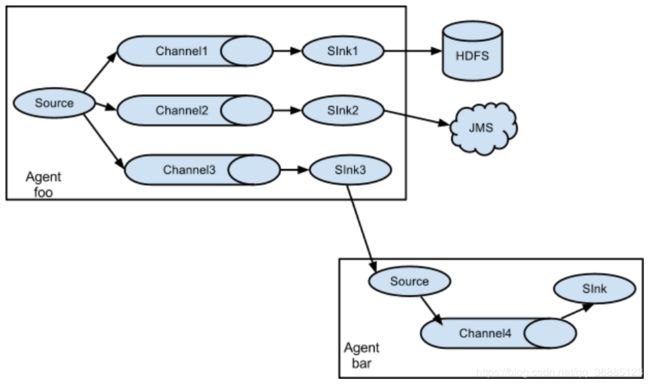hadoop Flume 操作实例(Flume 与 Flume 之间数据传递:单Flume 多Channel、Sink;多 Flume 汇总数据到单 Flume)
我的另一篇博客:
hadoop Flume 操作实例(监控端口数据、实时读取本地文件到 HDFS、实时读取目录文件到 HDFS)
环境配置:
Linux Ubuntu16.04系统
hadoop 2.7.2(一主master,二从slave1、slave2)
java jdk1.8.0_181
Flume 1.7.0
案例四:Flume 与 Flume 之间数据传递:单Flume 多Channel、Sink

目标:使用 flume-1 监控文件变动,flume-1 将变动内容传递给 flume-2,flume-2 负责存储到HDFS。同时 flume-1 将变动内容传递给 flume-3,flume-3 负责输出到local filesystem。
分步实现:
1)创建文件夹group-job1,在其中创建 flume-1.conf,用于监控 test.log 文件的变动,同时产生两个 channel 和两个 sink 分别输送给 flume-2 和 flume3:
# Name the components on this agent
a1.sources = r1
a1.sinks = k1 k2
a1.channels = c1 c2
# 将数据流复制给多个 channel
a1.sources.r1.selector.type = replicating
# Describe/configure the source
a1.sources.r1.type = exec
a1.sources.r1.command = tail -F /home/hadoop/test.log
a1.sources.r1.shell = /bin/bash -c
# Describe the sink
a1.sinks.k1.type = avro
a1.sinks.k1.hostname = master
a1.sinks.k1.port = 4141
a1.sinks.k2.type = avro
a1.sinks.k2.hostname = master
a1.sinks.k2.port = 4142
# Describe the channel
a1.channels.c1.type = memory
a1.channels.c1.capacity = 1000
a1.channels.c1.transactionCapacity = 100
a1.channels.c2.type = memory
a1.channels.c2.capacity = 1000
a1.channels.c2.transactionCapacity = 100
# Bind the source and sink to the channel
a1.sources.r1.channels = c1 c2
a1.sinks.k1.channel = c1
a1.sinks.k2.channel = c2
2)创建 flume-2.conf,用于接收 flume-1 的 event,同时产生 1 个 channel 和 1 个 sink,将数据输送给 hdfs:
# Name the components on this agent
a2.sources = r1
a2.sinks = k1
a2.channels = c1
# Describe/configure the source
a2.sources.r1.type = avro
a2.sources.r1.bind = master
a2.sources.r1.port = 4141
# Describe the sink
a2.sinks.k1.type = hdfs
a2.sinks.k1.hdfs.path = hdfs://master:9000/flume2/%Y%m%d/%H
#上传文件的前缀
a2.sinks.k1.hdfs.filePrefix = flume2-
#是否按照时间滚动文件夹
a2.sinks.k1.hdfs.round = true
#多少时间单位创建一个新的文件夹
a2.sinks.k1.hdfs.roundValue = 3
#重新定义时间单位
a2.sinks.k1.hdfs.roundUnit = minute
#是否使用本地时间戳
a2.sinks.k1.hdfs.useLocalTimeStamp = true
#积攒多少个 Event 才 flush 到 HDFS 一次
a2.sinks.k1.hdfs.batchSize = 10
#设置文件类型,可支持压缩
a2.sinks.k1.hdfs.fileType = DataStream
#多久生成一个新的文件
a2.sinks.k1.hdfs.rollInterval = 1
#设置每个文件的滚动大小大概是 128M
a2.sinks.k1.hdfs.rollSize = 134217700
#文件的滚动与 Event 数量无关
a2.sinks.k1.hdfs.rollCount = 0
#最小冗余数
a2.sinks.k1.hdfs.minBlockReplicas = 1
# Describe the channel
a2.channels.c1.type = memory
a2.channels.c1.capacity = 1000
a2.channels.c1.transactionCapacity = 100
# Bind the source and sink to the channel
a2.sources.r1.channels = c1
a2.sinks.k1.channel = c1
3) 创建 flume-3.conf,用于接收 flume-1 的 event,同时产生 1 个 channel 和 1 个 sink,将数据输送给本地目录:
# Name the components on this agent
a3.sources = r1
a3.sinks = k1
a3.channels = c1
# Describe/configure the source
a3.sources.r1.type = avro
a3.sources.r1.bind = master
a3.sources.r1.port = 4142
# Describe the sink
a3.sinks.k1.type = file_roll
a3.sinks.k1.sink.directory = /home/hadoop/flume3
# Describe the channel
a3.channels.c1.type = memory
a3.channels.c1.capacity = 1000
a3.channels.c1.transactionCapacity = 100
# Bind the source and sink to the channel
a3.sources.r1.channels = c1
a3.sinks.k1.channel = c1
注意:输出的本地目录必须是已经存在的目录,如果该目录不存在,并不会创建新的目录
4)写生成test.log的文件脚本run_job.sh:
vim run_job.sh
#!/usr/bin/env bash
#source /home/hadoop/.profile
while : ;
do starttime=$(date +%Y-%m-%d\ %H:%M:%S); echo $starttime + "Hello world!." >> /home/hadoop/test.log;sleep 0.1;
done;
使run_job.sh获得执行权限:chmod +x run_job.sh
5)执行测试:分别开启对应 flume-job(依次启动 flume-3,flume-2,flume-1),同时产生文件变动并观察结果:
flume-ng agent --conf conf/ --name a3 --conf-file job/flume-3.conf
flume-ng agent --conf conf/ --name a2 --conf-file job/flume-2.conf
flume-ng agent --conf conf/ --name a1 --conf-file job/flume-1.conf
./run_job.sh
案例五:Flume 与 Flume 之间数据传递,多 Flume 汇总数据到单 Flume

目标:flume-1 监控文件 hive.log,flume-2 监控某一个端口的数据流,flume-1 与 flume-2 将数据发送给 flume-3,flume3 将最终数据写入到 HDFS。
分步实现:
1)新建group-job2,在其中创建 flume-1.conf,用于监控 test.log 文件,同时 sink 数据到 flume-3:
# Name the components on this agent
a1.sources = r1
a1.sinks = k1
a1.channels = c1
# Describe/configure the source
a1.sources.r1.type = exec
a1.sources.r1.command = tail -F /home/hadoop/test.log
a1.sources.r1.shell = /bin/bash -c
# Describe the sink
a1.sinks.k1.type = avro
a1.sinks.k1.hostname = master
a1.sinks.k1.port = 4141
# Describe the channel
a1.channels.c1.type = memory
a1.channels.c1.capacity = 1000
a1.channels.c1.transactionCapacity = 100
# Bind the source and sink to the channel
a1.sources.r1.channels = c1
a1.sinks.k1.channel = c1
2)创建 flume-2.conf,用于监控端口 44444 数据流,同时 sink 数据到 flume-3:
# Name the components on this agent
a2.sources = r1
a2.sinks = k1
a2.channels = c1
# Describe/configure the source
a2.sources.r1.type = netcat
a2.sources.r1.bind = master
a2.sources.r1.port = 44444
# Describe the sink
a2.sinks.k1.type = avro
a2.sinks.k1.hostname = master
a2.sinks.k1.port = 4141
# Use a channel which buffers events in memory
a2.channels.c1.type = memory
a2.channels.c1.capacity = 1000
a2.channels.c1.transactionCapacity = 100
# Bind the source and sink to the channel
a2.sources.r1.channels = c1
a2.sinks.k1.channel = c1
3)创建 flume-3.conf,用于接收 flume-1 与 flume-2 发送过来的数据流,最终合并后 sink 到HDFS:
# Name the components on this agent
a3.sources = r1
a3.sinks = k1
a3.channels = c1
# Describe/configure the source
a3.sources.r1.type = avro
a3.sources.r1.bind = master
a3.sources.r1.port = 4141
# Describe the sink
a3.sinks.k1.type = hdfs
a3.sinks.k1.hdfs.path = hdfs://master:9000/flume3/%Y%m%d/%H
#上传文件的前缀
a3.sinks.k1.hdfs.filePrefix = flume3-
#是否按照时间滚动文件夹
a3.sinks.k1.hdfs.round = true
#多少时间单位创建一个新的文件夹
a3.sinks.k1.hdfs.roundValue = 5
#重新定义时间单位
a3.sinks.k1.hdfs.roundUnit = minute
#是否使用本地时间戳
a3.sinks.k1.hdfs.useLocalTimeStamp = true
#积攒多少个 Event 才 flush 到 HDFS 一次
a3.sinks.k1.hdfs.batchSize = 5
#设置文件类型,可支持压缩
a3.sinks.k1.hdfs.fileType = DataStream
#多久生成一个新的文件
a3.sinks.k1.hdfs.rollInterval = 1
#设置每个文件的滚动大小大概是 128M
a3.sinks.k1.hdfs.rollSize = 134217700
#文件的滚动与 Event 数量无关
a3.sinks.k1.hdfs.rollCount = 0
#最小冗余数
a3.sinks.k1.hdfs.minBlockReplicas = 1
# Describe the channel
a3.channels.c1.type = memory
a3.channels.c1.capacity = 1000
a3.channels.c1.transactionCapacity = 100
# Bind the source and sink to the channel
a3.sources.r1.channels = c1
a3.sinks.k1.channel = c1
4)执行测试:分别开启对应 flume-job(依次启动 flume-3,flume-2,flume-1),同时产生
文件变动:
flume-ng agent --conf conf/ --name a3 --conf-file job/group-job2/flume-3.conf
flume-ng agent --conf conf/ --name a2 --conf-file job/group-job2/flume-2.conf
flume-ng agent --conf conf/ --name a1 --conf-file job/group-job2/flume-1.conf
./run_job.sh
5)开新终端,使用 telnet 向 44444 端口发送内容
telnet master 44444
6)测试结果
在telnet输入任意字符,在flume-3终端查看结果


在master:50070查看文件系统中的文件:


